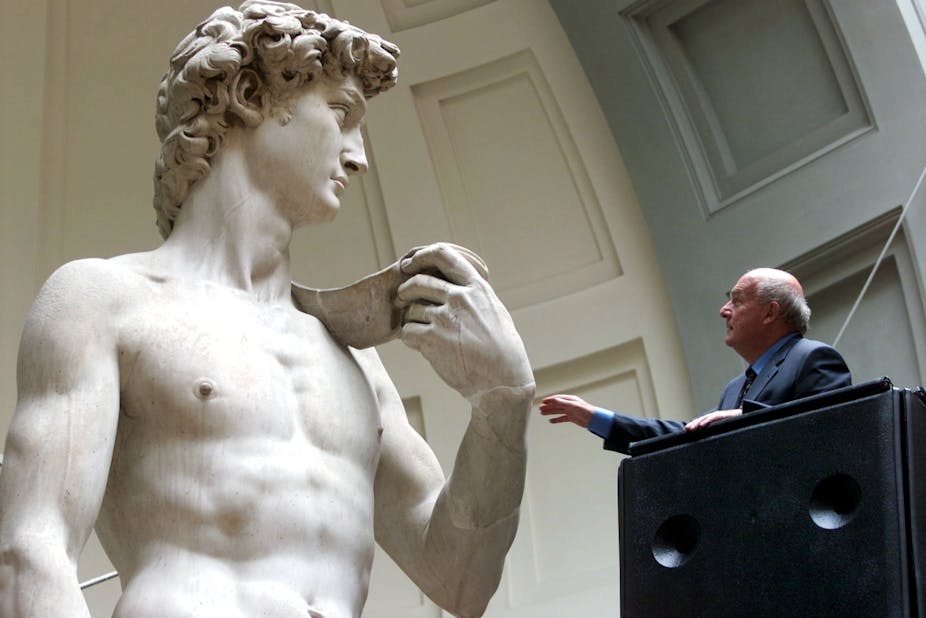He no longer looks like the eternal symbol of youth and beauty, but rather like the macho hero of an action film. The image of Michelangelo’s David holding a rifle in his hands featured in the last advert of the American small-arm engineering company ArmaLite has caused shock and controversy in the homeland of the early Renaissance sculpture.

“A work of art,” states the American advert, but the Italian government fails to see the artistic content of such a use of its cultural heritage.
Prominent Italian newspaper Le Repubblica reported that Cristina Acidini, the superintendent for Florence’s museums and heritage, is on the warpath. She said:
Of course, this is an international case and, clearly, I can’t unleash the FBI against ArmaLite. But I am going to make the most of every avenue open to me to make them desist.
And the Minister of Cultural Heritage and Activities Dario Franceschini tweeted:
The advertising image of David is offensive and against the law. We will take action against the American company, who must cancel the campaign.
The indignation of the Italian government is rooted in concerns over the cultural value of the image of Michalangelo’s David. But what kind of value are we talking about?
“Il David”, as it is commonly known in Italy, is the symbol of Florence’s artistic tradition, of the Renaissance and its humanistic values. This is the value that those who have cried in outrage align themselves with. Angelo Tartuferi, the director of Florence’s Accademia, has said, “The law states that the aesthetic value of the piece of art cannot be altered.”
The law he references is steeped in how Italy has historically viewed its culture. The philosopher Benedetto Croce in particular shaped the notion of cultural value in Italy for the most part of the 20th century. He put forward that the value of the arts was to be found in their “vision or intuition”, not in their utilitarian side.
So according to the Italian law, the original aesthetic value of a piece of art needs to be preserved in all circumstances, over and above any other instrumental values – such the economic one – that might also be attached to it. So while the Italian reaction may seem melodramatic, they do have a tentative legal right.
But, as stated by the La Repubblica article, it is easy to see that the primary concern of the Italian government is in fact the economic value of the image of the priceless statue. The strong reaction barely masks the anxiety to cash in on an artistic heritage whose preservation and promotion struggles every day under bureaucratic complexities, a lack of funding and a shortage of management skills.
The use of the image of the David for commercial purposes not only requires several authorisations by the Italian authorities but also, crucially, the payment of a fee to the Italian state. But the fame of Italy’s bureaucratic maze is sufficient to discourage anyone from seeking it. The Ministry of Cultural Heritage and Activities is really more concerned with the missed opportunity for foreign-earned income than aesthetically offended by the big weapon ruining David’s perfect contrapposto structure.

We can see this recent commercialisation of Italian cultural heritage elsewhere. Prime minister Matteo Renzi, during his term of office as mayor of Florence, proved to be an excellent businessman when managing the city’s artistic heritage. The most striking episode saw the historical bridge Ponte Vecchio closed to host a Ferrari corporate dinner. Both tourists and Florentines, without any notice, were denied access to the bridge and effectively prevented from being able to travel from one side of the town to the other in order to let the luxury brand have its dinner party undisturbed.
Florence has quickly become notorious for the availability (at a hefty price, of course) of its heritage sites for parties and ceremonies, from cocktails at the Uffizi to wedding receptions at Palazzo Pitti.

And Florence is not alone in this development: in Rome, the Colosseum’s image copyright has been sold to the Italian entrepreneur Diego Della Valle, who can also use its entrance tickets for advertising.
So ancient and Renaissance art is bending to financial pressures. But contemporary art is not responding in the same way. Although the traditionally conservative tendency of the Italian cultural sector has slowly begun to change, it still fails to keep up with European standards. Young Italian professionals from the sector face a deregulated job market that rarely acknowledges creativity as a professional skill and so they often seek better opportunities in other countries.
To add to an already difficult situation, public expenditure for culture in the past 12 years has almost been halved. These conditions leave little hope that Italy might be able to compete strongly on the global cultural stage, despite the efforts of the government to exploit the economic benefit of its national heritage. Just like David, the Italian cultural sector finds itself holding a slingshot against the giants, despite its effort to make it look like a rifle.

